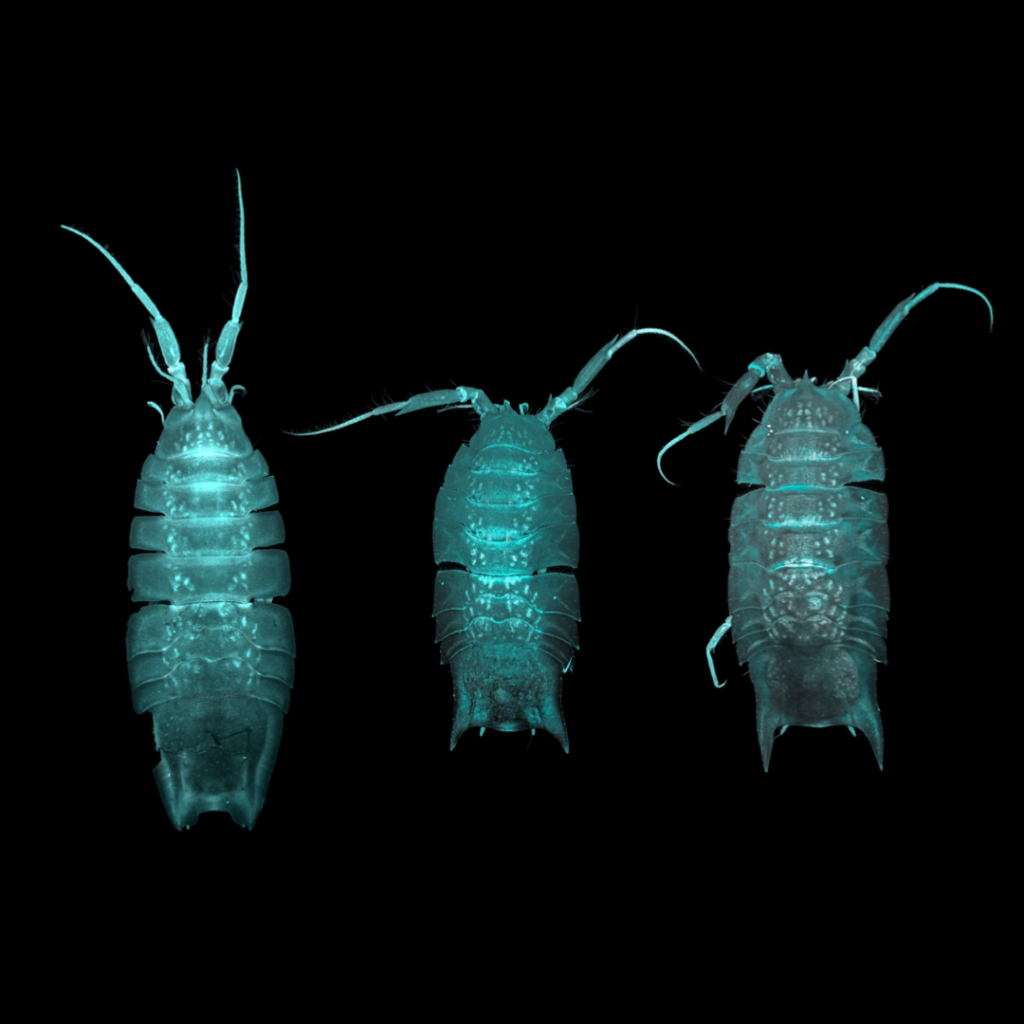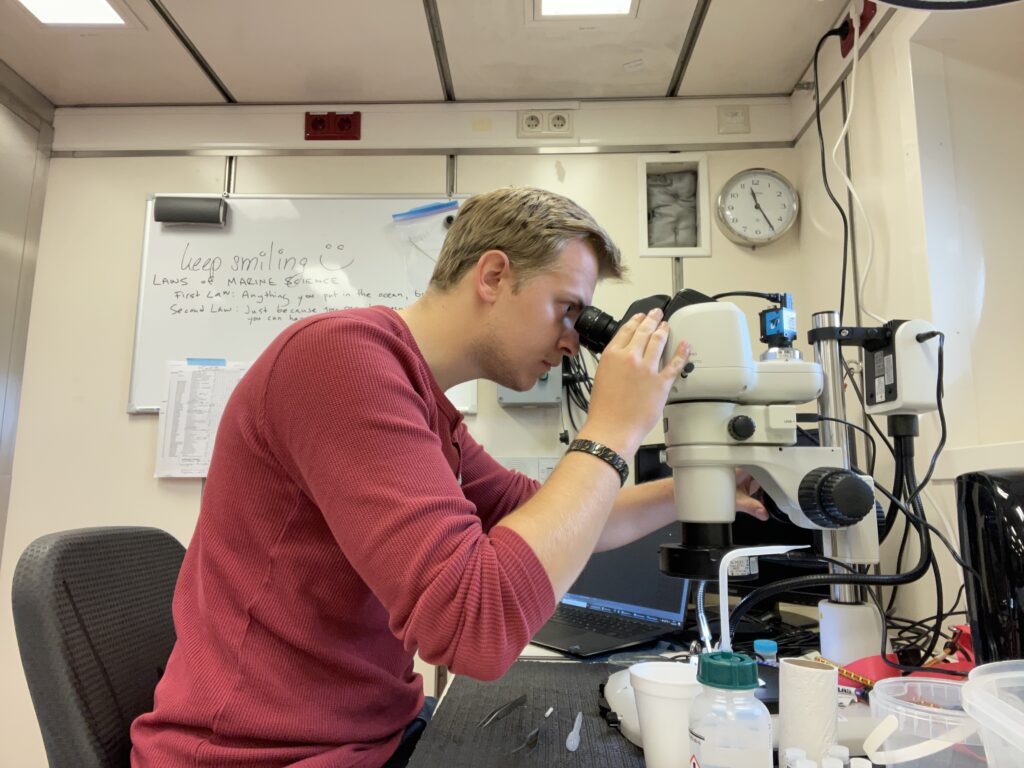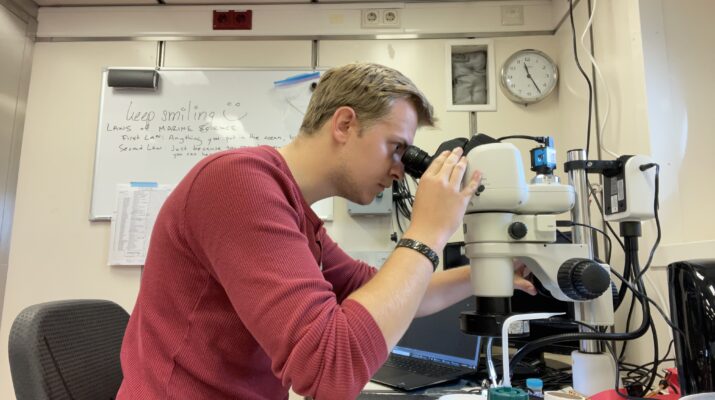Henry Knauber
Senckenberg Institute for Marine Zoology, Frankfurt, Germany
Twitter: @NorthFenris
Instagram: @abyss.arium
LinkedIn: https://www.linkedin.com/in/henry-knauber
Personal blog: https://abyssarium.wordpress.com
Contact: henry.knauber [ a.t ]senckenberg.de
What has been your personal journey into the deep-sea? (Did you always know this is what you wanted to do, or start out on a completely different path?) In other words, what unique journey led you to where you are now?
I have always been interested in marine biodiversity and explored it by reading books, watching documentaries, and visiting beaches during my vacations. However, my decision to become a marine biologist was solidified after working as an animal keeper for a year at the Danish Kattegatcentret aquarium and shark center. While I wanted to become a marine biologist that worked with sharks or cephalopods, studying biology in landlocked Frankfurt limited my options. Fortunately, Angelika Brandt, a deep-sea isopod specialist, moved to Frankfurt with her research group around the same time I started working towards my bachelor thesis. Since then, I’ve been working on the integrative taxonomy of deep-sea benthic isopods from the North Pacific and have become increasingly fascinated by it. In hindsight, I’m surprised that I didn’t consider deep-sea biology earlier because now I can’t think of a more interesting research area.
What is your current research question and why are you interested in this topic?
My PhD thesis focuses on small (<1 cm) deep-sea benthic isopods to understand how factors such as depth, geographic distance or bathymetric barriers like trenches and ridges promote differentiation and ultimately speciation processes in the deep sea. To investigate this question, I use integrative taxonomy in combination with population genetics and genomics. Although we know about the enormous, but mostly unknown, biodiversity that inhabits the deep sea, the evolutionary processes that cause it remain poorly understood. I am particularly interested in the biogeography of benthic species, how large or small their distribution range is, and why some are able to cross geomorphological barriers while other closely related taxa cannot.
What have been some challenges in your work or in studying the deep sea in general? Has your research turned out how you expected?
Working in taxonomy involves dealing with scarce specimen samples due to the inaccessibility of the deep sea. Although we retrieve many undescribed species whenever we sample the deep-sea floor during expeditions, most of them are rare, and in some cases, only single specimens of a new species are retrieved. Furthermore, the isopods I investigate have never been seen or studied alive, neither in retrieved samples nor on video footage (given their small size), so their actual ecology remains unknown, and we can only infer their lifestyle based on their morphology. These factors make taxonomic deep-sea research quite challenging, but also very interesting to me.

Why is this work important to you and society as a whole?
As we begin to understand the vast extent of deep-sea biodiversity, its evolutionary origin remains unclear. Understanding the role of deep-sea factors in evolutionary processes can help us identify areas that have the potential to host high levels of biodiversity, even if they have been understudied thus far. In the face of anthropogenic climate change, it is crucial to protect the deep sea due to its importance in global climate processes, especially since we know so little about it and can hardly grasp the consequences of reckless actions impacting the deep sea.
Because we are such an international organization, can you describe what the deep-sea science community is like in your region?
Deep-sea exploration and science have quite a rich history in Germany and its respective science community is therefore comparatively large (for deep-sea standards) and well- organized. The deep-sea community is spread across multiple research institutes and working groups, particularly in Northern Germany. Some notable institutions include the Senckenberg Institute for Marine Zoology in Frankfurt, where I work, Senckenberg am Meer in Hamburg and Wilhelmshaven, the Alfred Wegener Institute for Polar and Marine Research in Bremerhaven or the GEOMAR Helmholtz Centre for Ocean Research in Kiel. All of these institutions investigate marine, polar, along with deep-sea ecosystems and their biodiversity. Overall, the German deep-sea science community is quite diverse, including well-connected senior scientists as well as a growing network of young and early-career researchers.
What is your current position (student, researcher, government, non-profit etc.) and what do you like about your current role in deep-sea science?
I am currently a second-year PhD-student working at the Senckenberg Research Institute of Marine Zoology in Frankfurt, and am funded by a fellowship. I enjoy the thrill of exploring the deep sea and discovering new things firsthand on-board research vessels during expeditions as well as in the home laboratory. Beyond that, I also appreciate getting to know fellow scientists from around the world, exchanging ideas, and learning about different ways of doing scientific research to improve our understanding of the deep-sea realm from different perspectives. In addition, I’m also interested in science communication, which involves educating students and the general public about life as a deep-sea researcher and the wonders of the deep sea.

What advice could you offer to aspiring deep-sea biologists?
Overall, the deep-sea science community is smaller than one might think, but I have found it to be very welcoming. There are many different ways to dive into deep-sea science, so stay open- minded about how you can enter this field. Be aware, that life as a deep-sea scientist may be quite different from what you might expect – it can be very challenging sometimes, even for extended periods of your research. However, in return you will also experience very rewarding and joyful moments that make up for times of hardship. If you’re passionate about the deep-sea and deep-sea research sounds intriguing to you despite all the challenges, you should go for it!
What is the biggest challenge or project you look forward to addressing in the future?
Probably the biggest challenge about working as a taxonomist – especially in the deep sea – is the so-called taxonomic impediment. Species serve as the fundamental unit when working with
biodiversity in any given way. However, describing new species is a long and time-consuming process and the number of taxonomic experts is stagnating, leading to an ever-increasing pile of undescribed species discovered in the deep sea. In the future, I hope to speed up the species description process using modern imaging techniques and by rethinking the way species are defined and described, while still maintaining accuracy, to improve our understanding of deep- sea biodiversity.
What is your favorite thing about the deep sea?
My favorite thing about the deep sea is that it is a completely different world on our very own planet, about which we know so little. The conditions that define the deep-sea realm seem completely hostile to life from an anthropocentric perspective, but we still manage to find countless life forms that have adapted to these very conditions, leading to some of the most fascinating and unusual creatures I’ve ever seen or heard of. Exploring one of the last frontiers in biological research and discovering what kind of live exists in the deep sea is what excites me the most.
Follow Henry on Instagram (@abyss.arium), Twitter (@NorthFenris), as well as Linkedin, and visit Henry’s fantastic blog: https://abyssarium.wordpress.com/


